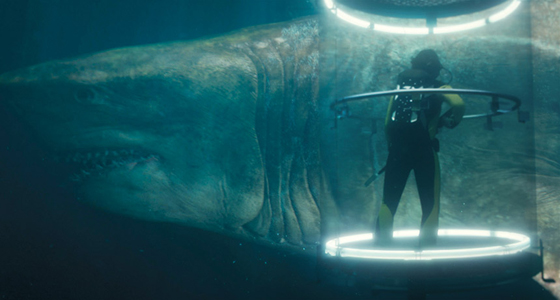Megalodon Makes it to the Big Screen
This weekend sees the opening of the summer blockbuster “Meg”, a prehistoric shark-based action movie featuring Jason Statham and a twenty-five-metre-long representation of Carcharocles megalodon – Megalodon, an extinct species of prehistoric shark, so famous that it is just known by its specific or trivial name.
Commenting on a Prehistoric Shark
With the film likely to make in excess of £30 million in box office receipts on just its opening weekend in the USA, the movie, which incidentally is the most expensive shark film ever made (estimated budget of around $130 million USD), is likely to be a runaway box office success. However, this iconic marine monster is well and truly extinct, it really is “safe to enter the water” to borrow a strapline from perhaps, the best-known and best-loved shark movie of them all, the 1975 “Jaws”.
Warner Bros and director Jon Turteltaub may have resurrected Megalodon, but most palaeontologists will confidently tell you that, what was probably the largest carnivorous shark to have existed, died out around 2.6 million years ago.
When those talented people as Safari Ltd introduced a “Megalodon” model back in 2014, Everything Dinosaur put together a short video introduction to the model.
Everything Dinosaur’s Video Review of the Wild Safari Dinos Megalodon Model
Video credit: Everything Dinosaur
We may have lacked the budget of the movie and unfortunately, we were unable to afford the services of Jason Statham, but our six minute video review set out to explain a little more about the science behind this prehistoric shark and to provide a guide to the Wild Safari Prehistoric World Megalodon model.
Carcharocles megalodon (Otodus megalodon)
Many marine biologists had believed that Carcharocles megalodon was closely related to the modern Great White Shark – Carcharodon carcharias (hence Everything Dinosaur’s original research into finding a suitable Megalodon model). However, recent studies suggest that it was actually a member of another sub-branch of the Lamniformes Order and that Megalodon was a member of the Otodontidae family and not a member of the Lamnidae family as previously thought.
It may have had a similar lifestyle and habit to the Great White Shark and it was much bigger and heavier, but it was unlikely to have been around twenty-five metres in length, the size of Megalodon in the movie.
A Still from the Motion Picture “Meg”

Picture credit: Warner Bros
A spokesperson from Everything Dinosaur commented:
“If these giant, prehistoric sharks were still around today, then, as we suspect they were shallow water specialists living in the top two hundred metres of water, the upper portions of the epipelagic zone of the ocean, then they certainly would have been spotted by now. The “Meg” is very much extinct and we are sure that the film will provide plenty of thrills and spills for cinema goers. Perhaps, it will also raise awareness amongst its audience about the plight of many shark species today. Over fishing, habitat loss and pollution are having a devastating effect on global shark populations. It has been estimated that some 100 million sharks die each year, with luck this movie will raise awareness about shark species conservation.”
Visit the Everything Dinosaur website: Everything Dinosaur.
The Tooth from a Megalodon Shark

Picture credit: Everything Dinosaur
Safari Ltd have produced an excellent replica of this prehistoric shark, to view the model and the rest of the amazing figures in the Wild Safari Dinos Prehistoric World collection: Safari Ltd. Wild Safari Prehistoric World.
The Wild Safari Prehistoric World Megalodon Figure

Visit the award-winning Everything Dinosaur website: Everything Dinosaur.
Please note, following a scientific revision the binomial name for this shark has been changed. Most palaeontologists refer to this species as Otodus megalodon.






Leave A Comment